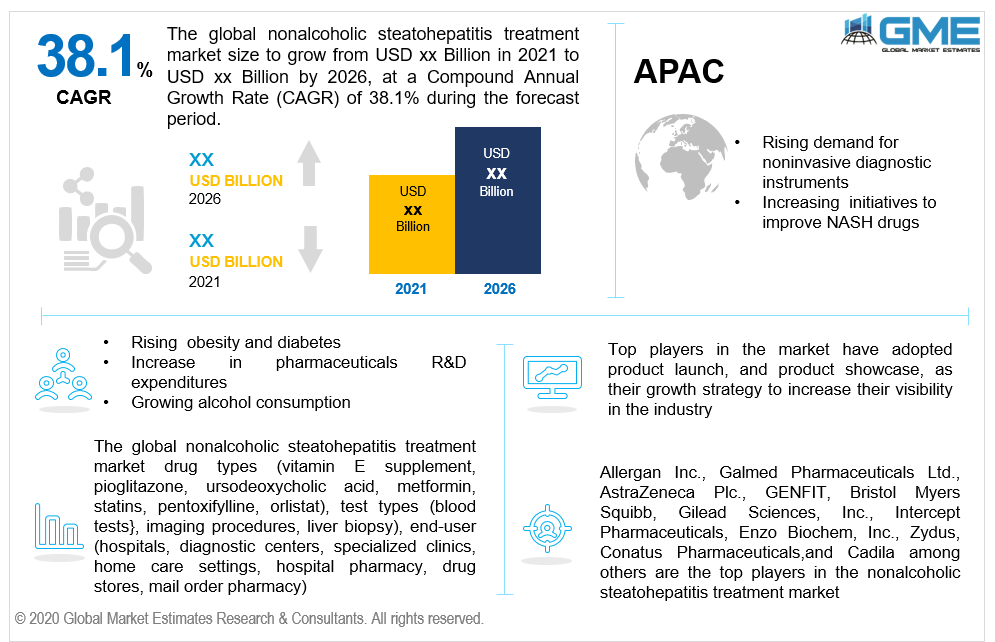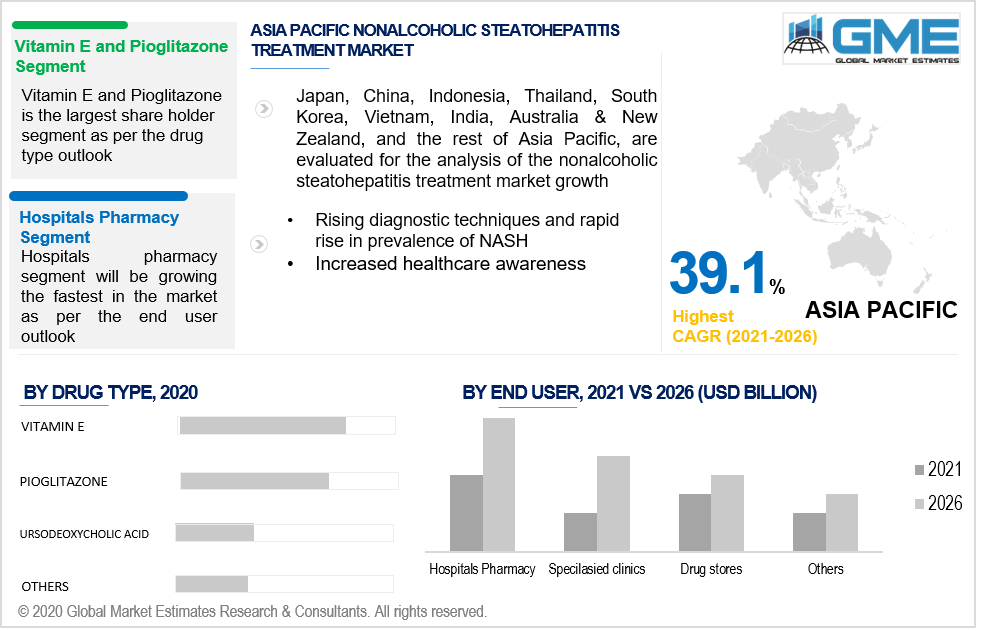
Global Non-alcoholic Steatohepatitis Treatment Market Size, Trends & Analysis - Forecasts to 2026 By Drug types (Vitamin E Supplement, Pioglitazone, Ursodeoxycholic Acid, Metformin, Statins, Pentoxifylline, Orlistat), By Test types (Blood Tests {Complete Blood Count, Fasting Blood Sugar, Liver Enzyme And Liver Function Tests, Celiac Disease Screening Test, Tests For Chronic Viral Hepatitis (Hepatitis A, Hepatitis C And Others), Lipid Profile, Which Measures Blood Fats, Such As Cholesterol And Triglycerides, Haemoglobin A1c, Which Shows How Stable Your Blood Sugar Is}, Imaging Procedures {Abdominal Ultrasound, Magnetic Resonance Imaging (MRI), Computerized Tomography (CT) Scanning, Magnetic Resonance Elastography, Transient Elastography}, Liver Biopsy), By End-User (Hospitals, Diagnostic Centers, Specialized Clinics, Home Care Settings, Hospital Pharmacy, Drug Stores, Mail Order Pharmacy), By Region (North America, Europe, Asia Pacific, MEA, and CSA), End-User Landscape, Company Market Share Analysis, and Competitor Analysis
Non-alcoholic steatohepatitis is a form of liver disease that affects people who aren't alcoholics or who only drink occasionally. Non-alcoholic steatohepatitis (NASH) is a type of non-alcoholic fatty liver disease (NAFLD) that causes hepatitis and liver inflammation and can cause liver damage. Complications from NASH include cirrhosis and liver cancer. Patients with NASH have a high risk of death from liver-related causes such as liver failure.The non-alcoholic steatohepatitis (NASH) market is expected to grow by double digits over the forecast timeframe due to the demand for ideal NASH Therapeutics, an increase in the prevalence of NASH, and the anticipated launch of pipeline drugs.
The market drivers which contribute to the non-alcoholic steatohepatitis treatment market include obesity and diabetes which are becoming more common, increased calorie intake associated with processed food consumption, rising alcohol consumption, rising demand for non-invasive diagnostic instruments, rising patient awareness, and initiatives to improve NASH drugs.Over the forecast era, the production of NASH biomarkers is expected to be aided by increasing demand for non-invasive diagnostic tools and increased patient awareness. The low use of invasive procedures for disease diagnosis is due to the high cost of liver biopsy, its invasiveness, and patients' limited acceptance.
The main treatment for non-alcoholic fatty liver disease is lifestyle modification, which involves nutritional and physical activity modifications.However, in some circumstances, dietary change is impossible to obtain and maintain, necessitating the use of additional medications, including medication.As per a Lancet survey, between 1980 and 2013, the global incidence of obesity among adults increased by 27.5 percent. As perthe National Health and Nutrition Examination Survey (NHANES) 2014 data, the percentage of obese people in the United States is higher in women, at 40% than in men, at 35%.
Obesity and diabetes are becoming more common in developed and developing economies as a result of sedentary lifestyles, increased calorie intake associated with processed food consumption, and alcoholism, both of which are likely to fuel the development of non-alcoholic steatohepatitis (NASH) industry.

Based on drug type, the market is segmented intoVitamin E Supplement, Pioglitazone, Ursodeoxycholic Acid, Metformin, Statins, Pentoxifylline, and Orlistat.
Because of its effectiveness, the vitamin E & pioglitazone category currently dominates the non-alcoholic steatohepatitis (NASH) market. The elafibranor and selonsertib&cenicriviroc parts, on the other hand, are expected to rise significantly in the future, owing to their efficacy in severely affected NASH patients.
Based on test type, the market is segmented into blood tests, liver biopsy, and imaging procedures.During the forecast period, the market for liver biopsy is estimated to dominate the market.When blood samples and serology tests fail to determine the cause of liver disease, a tissue extract from the liver is removed for analysis. Among the conditions requiring a liver biopsy are alcoholic liver disease, fatty liver disease, cirrhosis, infectious hepatitis, and autoimmune hepatitis, among others.The demand will be fueled by increasing public awareness, as well as the availability of low-cost biopsy equipment and instruments. The increased prevalence of liver disorders around the world necessitates the use of liver biopsies for diagnosis.
Based on end-user, the market is segmented into hospitals, diagnostic centers, specialized clinics, home care settings, hospital pharmacies, drug stores, and mail-order pharmacies.The hospital pharmacy segment contributes largely the most revenue and is projected to continue to do so over the forecast timeframe owing to the extensive presence of drug stores and retail pharmacies around the globe. On the other hand, the online pharmacy segment is expected to grow due to increased awareness of online pharmacies and a preference for online sales over traditional methods.

As per the geographical analysis, the market can be classified into North America (the US, Canada, and Mexico), Asia Pacific (India, China, Japan, Malaysia, Singapore, and Rest of Asia Pacific), Europe (Germany, United Kingdom, Italy, France, Spain, Netherlands, and Rest of Europe), Middle East & Africa and Central South America.
Because of the rising prevalence of obesity and fatty liver in North America and Europe, the non-alcoholic steatohepatitis treatment market is expected to rise significantly. The rising prevalence of diseases in the area is providing drug makers with favorable growth opportunities. Key regional manufacturers are investing in R&D to accelerate the production of novel drugs for the treatment of non-alcoholic steatohepatitis (NASH).The main players in the non-alcoholic steatohepatitis (NASH) industry will find lucrative opportunities in Asia-Pacific. Some of the factors driving market growth in Asia-Pacific are advancements in diagnostic techniques, the rapid rise in occurrence of NASH, economic growth, and increased demand for NASH therapeutics. Other factors such as expanding healthcare infrastructure, developing economies, and a rising rate of diagnosis are anticipated to boost the Asia-Pacific non-alcoholic steatohepatitis (NASH) industry. Furthermore, rising healthcare awareness in emerging economies such as India and China is propelling the market forward.
Allergan Inc., Galmed Pharmaceuticals Ltd., AstraZeneca Plc., GENFIT, Bristol Myers Squibb, Gilead Sciences, Inc., Intercept Pharmaceuticals, Enzo Biochem, Inc., Zydus, Conatus Pharmaceuticals,and Cadila, among others, are the top players in the nonalcoholic steatohepatitis treatment market
In September 2019, Intercept Pharmaceuticals, a biopharma firm, revealed that it had submitted its obeticholic acid (OCA) New Drug Application (NDA) to the FDA. It is used to treat patients who have developed fibrosis as a result of NASH. OCA is the only treatment that has met the goal of a Phase 3 trial in patients with NASH.
Please note: This is not an exhaustive list of companies profiled in the report.
We value your investment and offer free customization with every report to fulfil your exact research needs.
The Global Non-alcoholic Steatohepatitis Treatment Market has been studied from the year 2019 till 2026. However, the CAGR provided in the report is from the year 2021 to 2026. The research methodology involved three stages: Desk research, Primary research, and Analysis & Output from the entire research process.

The desk research involved a robust background study which meant referring to paid and unpaid databases to understand the market dynamics; mapping contracts from press releases; identifying the key players in the market, studying their product portfolio, competition level, annual reports/SEC filings & investor presentations; and learning the demand and supply-side analysis for the Non-alcoholic Steatohepatitis Treatment Market.

The primary research activity included telephonic conversations with more than 50 tier 1 industry consultants, distributors, and end-use product manufacturers.

Finally, based on the above thorough research process, an in-depth analysis was carried out considering the following aspects: market attractiveness, current & future market trends, market share analysis, SWOT analysis of the company and customer analytics.

Tailor made solutions just for you
80% of our clients seek made-to-order reports. How do you want us to tailor yours?
OUR CLIENTS